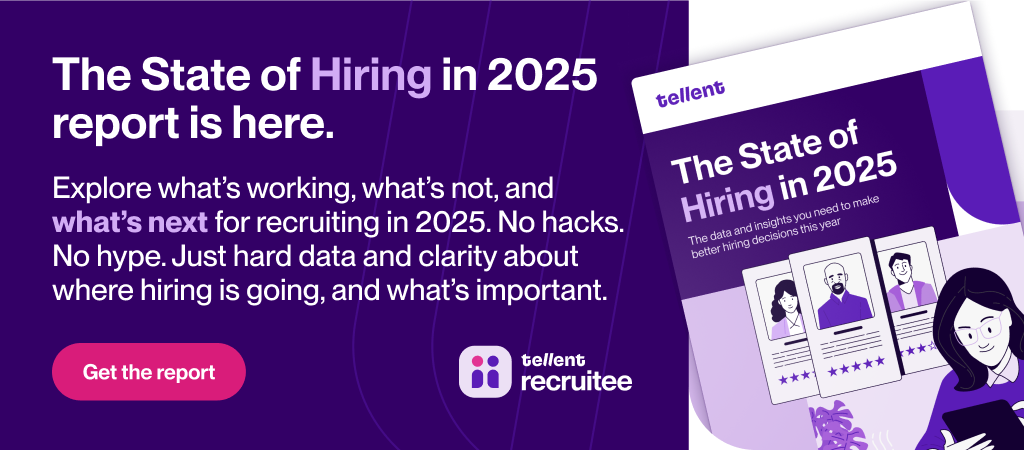A solid career page is a hiring organization’s best tool for creating and nurturing their employer brand. In fact, according to our The State of Hiring in 2025 report, the longer applicants spend on your career site, the more likely they are to apply.
No other hiring platform offers the same depth of content, customizability, and traffic growth potential as a careers page. It’s where you can put your absolute best foot forward, and make a strong case for why you’re an ideal employer for your target candidates.
When showcasing your employer brand, your number one priority should be to give job seekers the content and stories they need to make an informed decision about their own fit at your company. Careers pages are the primary platform at your disposal to do so.
Yes, careers pages and employer branding are two peas in a pod.
Done right, this portion of your website can and will be your best weapon for inbound applicants and talent growth. But how exactly do you build one? And what makes a good careers page? This article will guide you through that process.
But first, let’s take a step back and discuss what a careers page is, and how they relate to employer branding.
What is a careers page?
A careers page, or careers site, is a section of your website dedicated to showcasing your employer brand and presenting job openings.
It can be a single landing page, a microsite, or a hybrid web page and jobs board.
However you include a careers page on your website, it should have a singular focus to tell job seekers who you are, your values, why your employees like working there, and what’s in it for new applicants.
Your careers page's messaging and content act as the first point of contact for new applicants, and they will use it to assess whether or not to click “Apply.”
In addition to employer brand content, careers pages will often include vacant positions either on the page itself or via a link to a third-party platform. In addition to being your core employer branding platform, careers pages also serve as application portals for potential candidates.
Here’s what Tellent’s careers page looks like, if you’re curious.
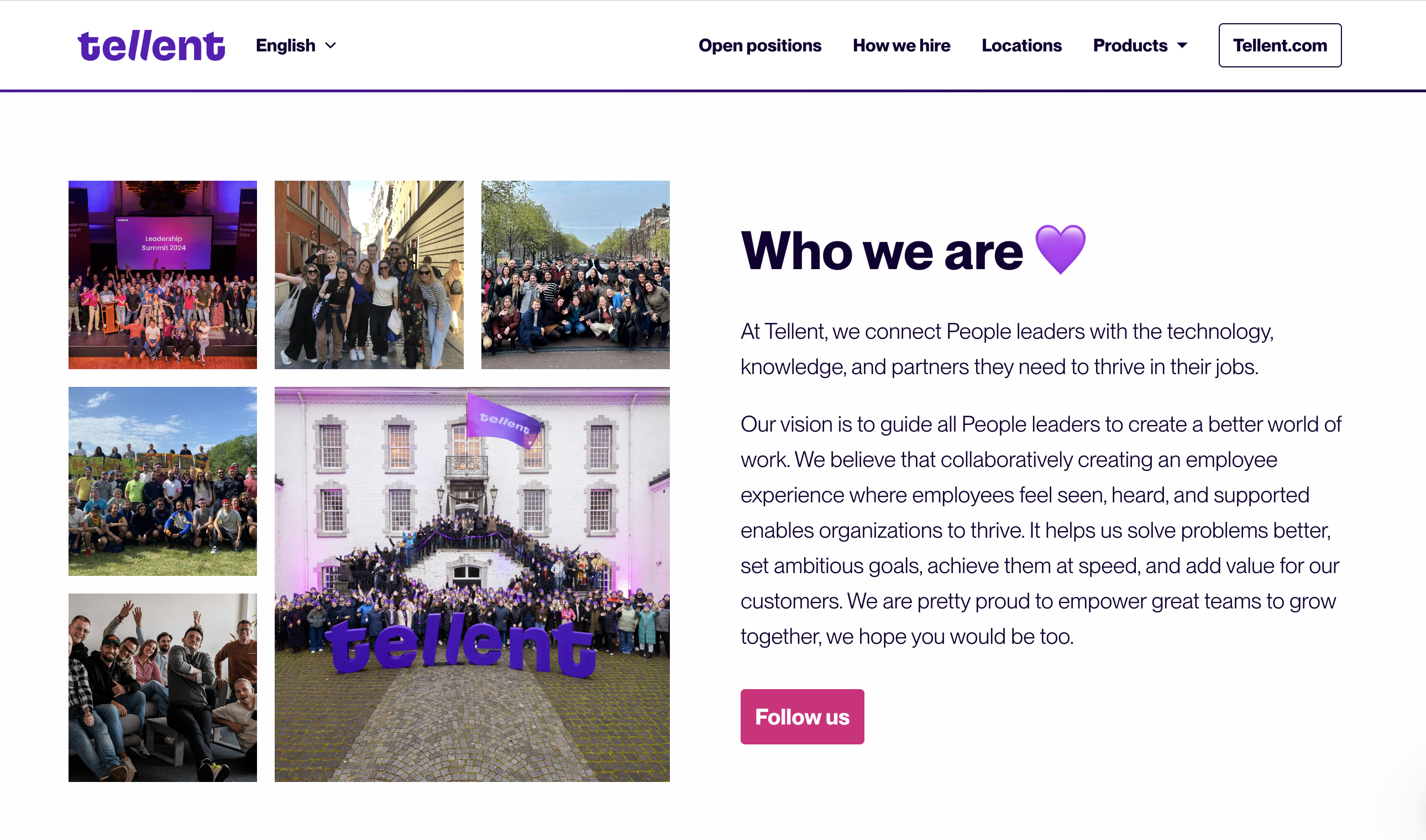
Why are careers pages important?
Your careers page is one of the most powerful tools you have for attracting the right candidates. In fact, our State of Hiring in 2025 report found a clear link between careers pages and hiring success.
Here’s the simple truth: when candidates spend more time on your careers page, they’re more likely to apply—and more likely to move further in your hiring process.
Looking at the European market, we found some big differences. Companies in France are leading the way, with strong careers page engagement and higher application completion rates. In Germany, though, the story is different: careers pages see a 70% bounce rate and much lower conversion rates.
Even more interesting, companies that kept candidates on their careers pages longer tended to fill open roles faster. In other words, a well-designed careers page and strong employer branding don’t just look good—they help you reduce your time to hire.
The data is clear: great careers pages lead to better hiring. But why exactly does that happen? Let’s break it down.
1. The ability to control the story you tell to job seekers
For many candidates, your careers page is their very first interaction with your company. That makes it a powerful chance to tell your story the way you want it told. Unlike job boards or third-party platforms, you own the entire candidate experience—from the design to the content to the tone of voice.
When you use that space to speak directly and honestly to your ideal candidates, you increase the chances they’ll see themselves at your company and hit “apply.”
2. They’re gold mines for organic traffic
Think back to when you’ve searched for jobs—how often did you type “company + careers” or “industry + careers” into Google? That’s one of the first steps job seekers take. Careers pages give you the chance to show up in those searches and capture that traffic without paying for ads.
And here’s where it gets interesting: if spending more time on your careers page makes candidates more likely to apply (as our research shows), then bringing in more of that organic traffic directly leads to more qualified applications.
3. They engage visitors and showcase your brand
Your careers page isn’t just a list of jobs—it’s your main stage for employer branding. With the right mix of engaging content, clear storytelling, and a smooth user experience, it can do far more than inform. It can inspire.
Every extra minute someone spends on your page boosts the odds they’ll apply. Every drop in bounce rate helps too. By creating careers pages that people actually want to explore, you set yourself up for better hiring outcomes.
4. They improve your hiring metrics
As we’ve covered, careers pages have a positive impact on cost per hire and time to hire. Companies with higher visit durations on their careers pages tend to have a lower time-to-hire. Conversely, companies with high bounce rates tend to also have longer time-to-hire cycles.
Additionally, more applicants will find a well-structured careers page organically through Google search or even LLMs like ChatGPT, reducing the need for paid candidate sourcing. Incorporating SEO best practices into your careers page, therefore, is also a good idea for inbound application strategies.
Lastly, concise brand and employer messaging helps candidates pre-screen themselves to establish fit. This has the net benefits of improving applicant quality, by attracting candidates who have a genuine fit with your company.
A strong careers page doesn’t just look good—it moves the numbers that matter. Companies with high engagement on their careers pages consistently see faster time-to-hire and lower cost-per-hire. On the flip side, companies with high bounce rates tend to struggle with longer, more expensive hiring cycles.
Well-structured pages also rank better on Google and can even show up in AI tools like ChatGPT, which means more inbound applicants and less need for paid sourcing. Plus, clear messaging helps candidates self-select, which means higher-quality applications.
5. You can track visitors to your careers pages.
Finally, because careers pages live on your own website, you can track almost everything—traffic, location, demographics, engagement, and more. These insights help you understand who’s visiting and what’s resonating, so you can refine your content and UX to improve results.
The best careers pages are easy to find, answer the key questions candidates have, and connect seamlessly to a simple, reliable application process. When you bring all those pieces together, you create a candidate experience that doesn’t just attract talent—it consistently turns visitors into new hires.
Download The State of Hiring in 2025 report, which provided real-world statistics and insights from thousands of European companies.
How careers pages showcase your employer brand (with examples)
Before we dive into the specifics of how to create a successful careers page, let’s step back to discuss ways you can inject your employer brand identity into your messaging.
There’s no one way to do this, and your employer brand will likely develop over time. But in general, here are some common techniques for showcasing an employer brand on a careers page:
Adapt your company brand messaging to your careers page
Your employer brand and company brand should be more or less two sides of the same coin.
The values that you hold as an organization should be clearly evident in all brand messaging, and you should use that as your roadmap for how to present yourself to job seekers.
This will also ensure that your organization isn’t telling two conflicting brand stories.
Take Shopify, for example. This is the message they show at the top of their careers page. It’s direct, highly on brand, and doesn’t hold back in telling visitors exactly what the company is looking for. This message doesn’t appeal to everyone, and that’s the point. Shopify is unapologetically injecting their brand message right at the start of the candidate journey to help ensure they get the most suitable applicants.
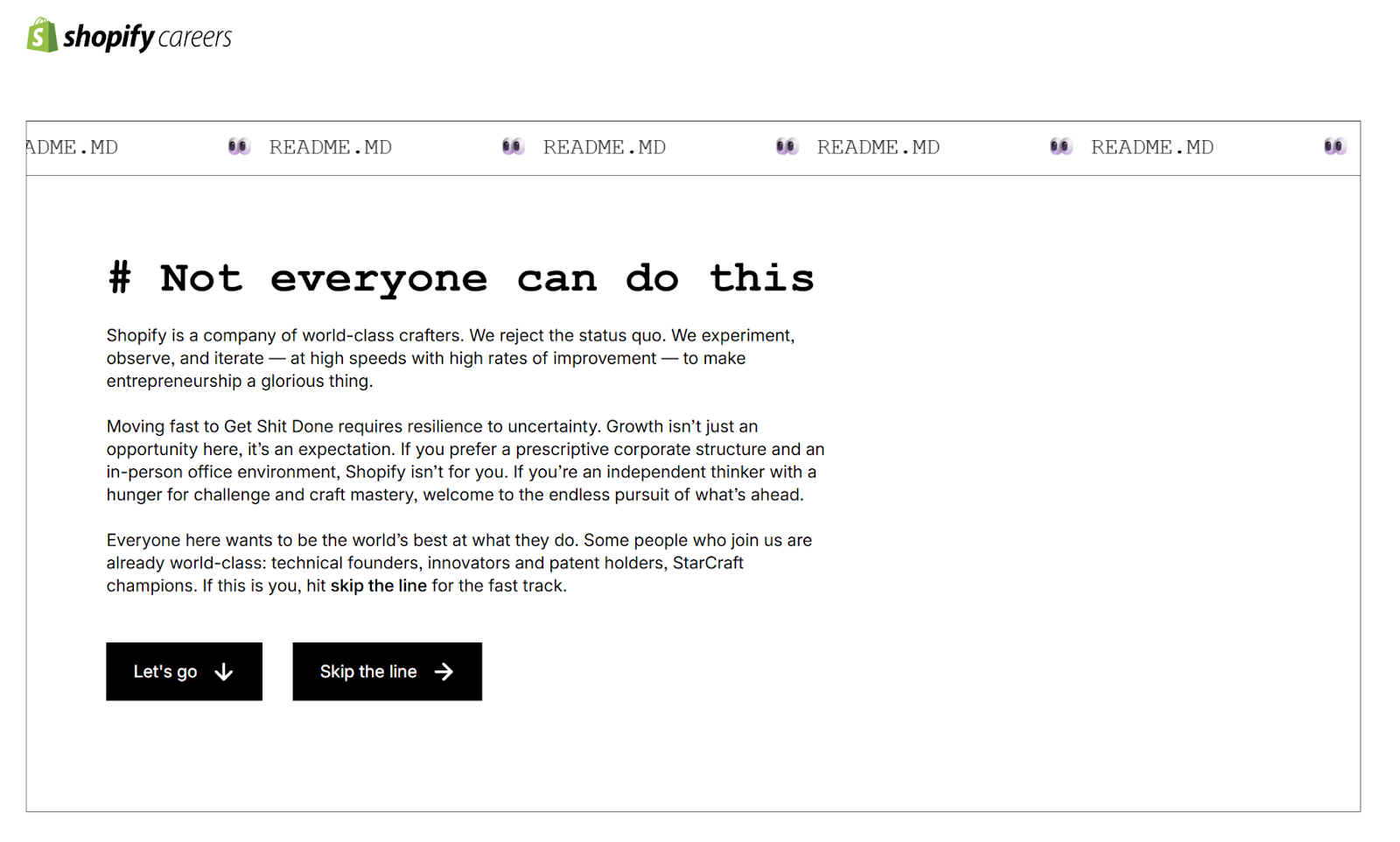
Use various media to tell your story
People consume information in a variety of different ways. And no, not all stories are suited to every type of media.
Be deliberate about what content you present to visitors, how you present it, and what medium you choose. Value proposition messaging, for example, is usually best delivered through text.
Employee testimonials, on the other hand, require a more personal feel. So, video is the way to go.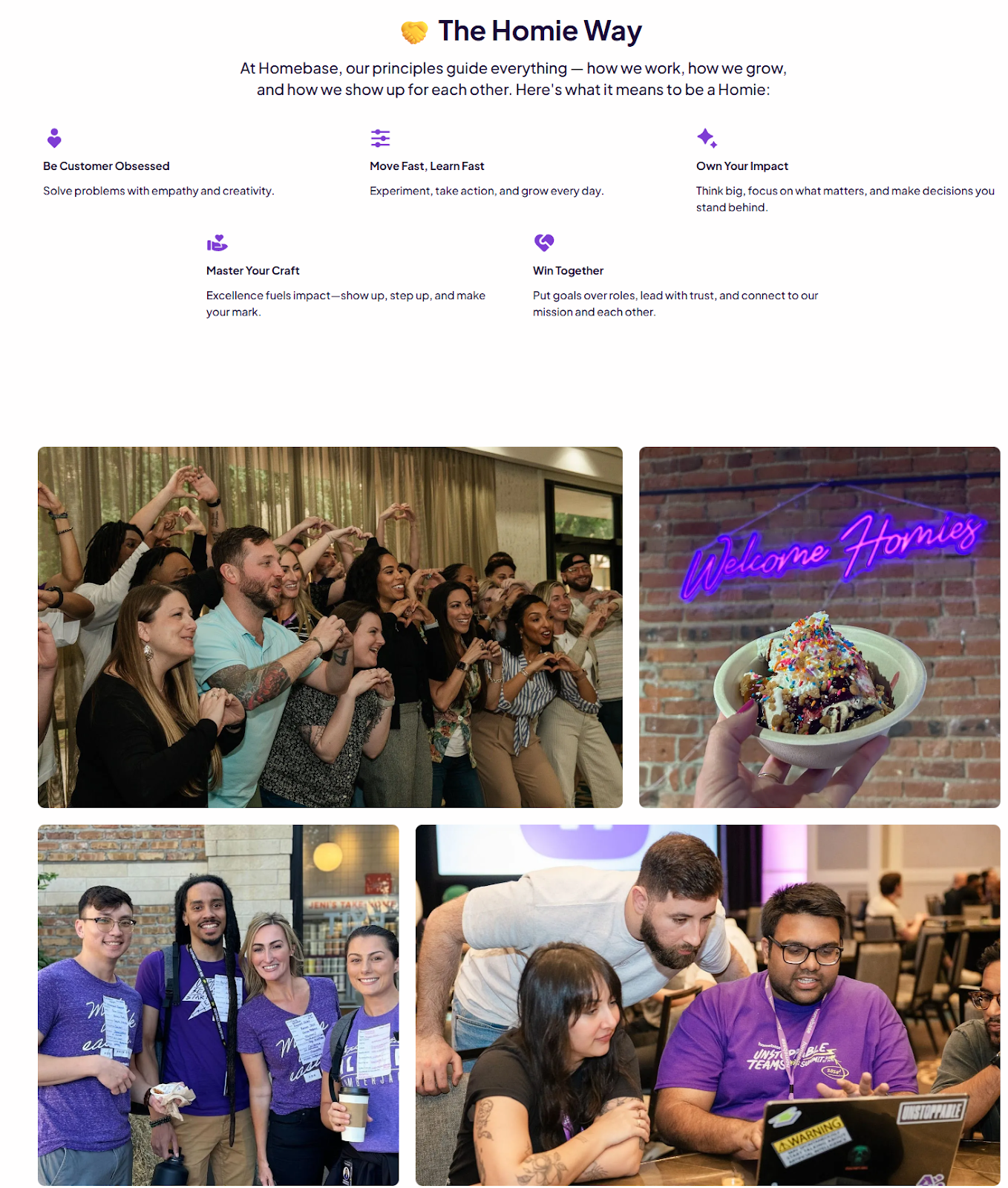
Draw a line in the sand
Clearly establish who you are as an employer, and who you aren’t. This will help keep your messaging clear and focused on what you’re trying to achieve and offer to job seekers. Trying to do too much creates an unclear employer brand.
Shopify’s example above is a direct, if you face example of this. You can also take a page out of Accenture’s book to include a clear hero message at the top of your careers page that says who you are, what you do, and who is welcome at your company.
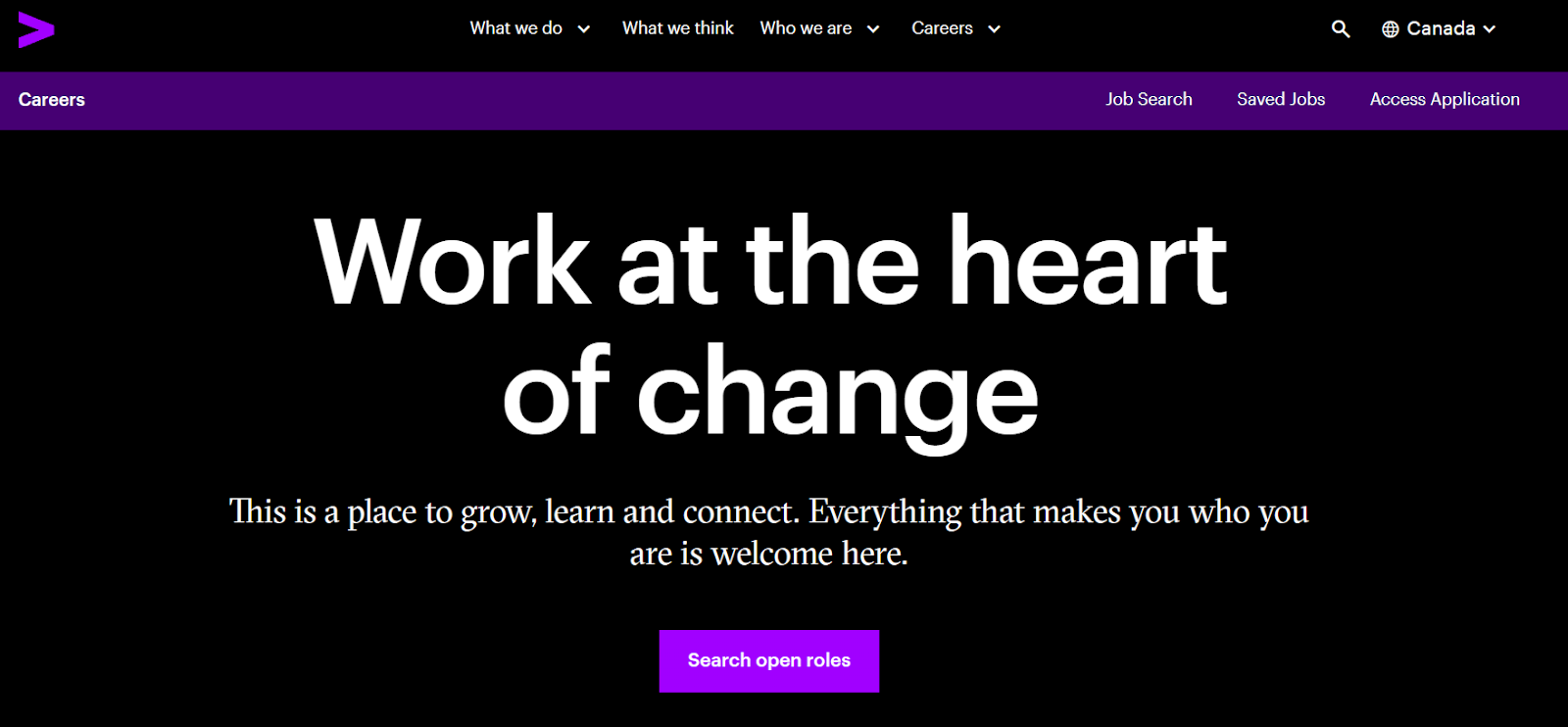
Have ideal candidates in mind
This doesn’t mean that you need to speak to every ideal candidate for every job opening you have. But it does mean that you need to establish what characteristics you’re looking for in all employees. Once you know that, it will become easier to write or create content that speaks to those traits.
Netflix takes this concept deeply to heart. Their careers page is actually many pages rolled into a full-blown careers site. They have a culture page, shown below, which clearly lays out their company vision, and what traits their ideal candidates will have. This makes it very clear and very easy for candidates to understand what Netflix is looking for, and whether they’re truly suited to the role and company.
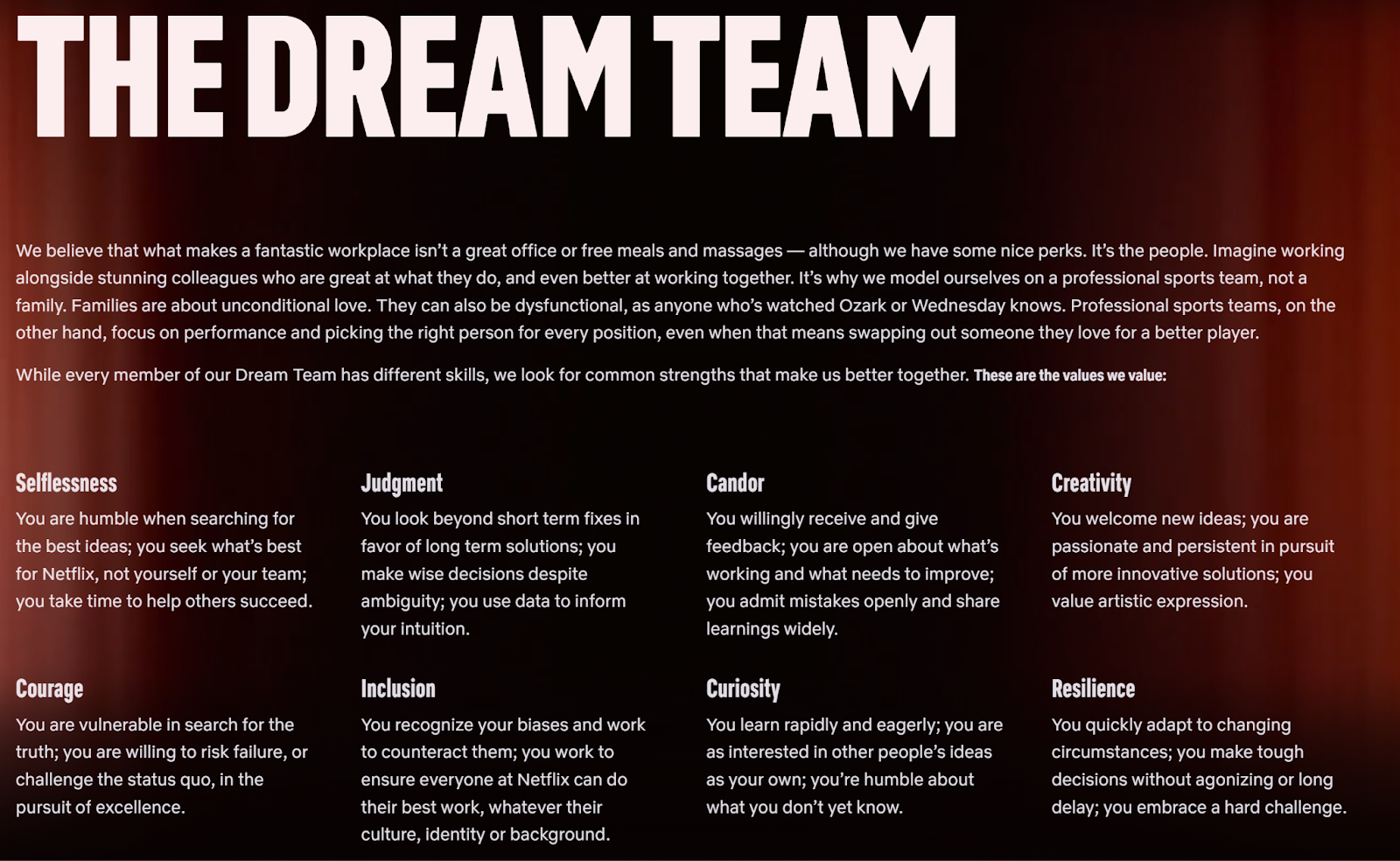
Live what you say
It’s not enough to have pretty content and nice promises on the page. Your organization has to live those promises at each touchpoint in a new applicant’s interactions with your company.
That means your candidate experience, onboarding, and work-life all have to live up to the promises you made. If they don’t, then you’ll likely find yourself with applicant drop off or retention issues.
Now that we’ve driven home the importance of career pages for employer branding let’s dig into how to create one of these things. The good news is that if you’ve ever created a web page, you will likely already know some best practices you’ll need to follow.
Key considerations when creating a careers page strategy
Developing a careers page strategy is all about understanding who you’re creating it for in the first place. Let your ideal candidates tell you what they want to see on your careers page.
How do you find that out?
Ask your new hires - the ones that you likely hired because they were an ideal candidate. Get their take on what they would have liked to see when they were researching your company.
From there, you can look at careers page examples from your competitors and integrate the elements you like into your own website.
A solid career page strategy comes down to three key elements: career page design, career page content and careers site analytics. Let’s dig into each.
Career page design
Careers page design should follow the same best practices you’d use for general web or UX builds, but with the critical goal of delivering your Employer Value Proposition (EVP), and encouraging a seamless transition from research to application.
The number one priority is a positive, easy-to-follow user experience. Your design must align visually with your core brand, but be optimized for the candidate journey.
To do so, make sure you incorporate the following design elements:
- Authentic visuals: Use real employee photos and videos instead of stock images to build immediate trust. Authenticity is a non-negotiable for modern candidates.
- Mobile-first design: The entire page, especially job listings and application forms, must be lightning-fast and fully functional on all mobile devices, as most candidates start their search here.
- Clear work model communication: Design elements must clearly and consistently communicate your Hybrid or Remote work policies. In our ‘The State of Hiring in 2025’ report, we found that candidates need to know upfront what the work arrangement will be, or they are highly likely to drop off early in the hiring process.
- Seamless application flow: Designs should guide the user with persistent, high-contrast Calls-to-Action (CTAs). The application form itself must be short, clean, and fully branded to prevent drop-off.
- Social proof: Use visual blocks to embed employee testimonials, video clips, and employer recognition badges to instantly validate your culture.
- Compliance transparency: For European talent, prominently display links to your GDPR and Privacy Policy near application points. A compliant design builds confidence.
- Simplified search: Feature a highly visible, fast search bar with intuitive filters for location, department, and work type.
All of that is in addition to a design that feels on-brand, and integrates with the rest of your website. And, of course, you don’t need to perfect your careers page on the first try, but you do need to monitor performance and adapt as needed.
Tip: Use Tellent Recruitee’s CareerHub to easily create a fully-functional, on-brand careers site. Watch the video below to learn more.
Career page content
One could argue that career page content is even more important than the design you choose. That’s because the content is the main vehicle by which you tell your employer branding story, and make your case for why an applicant should apply to your company.
Because of this importance, it’s critical that you include the right subject matter on your career page and deliver it using the right medium.
Some of the most common types of information found on career pages include:
- Company values
- Employee testimonials
- Photos and videos
- An overview of what your company does
- Company history
- Reasons why employees work there
- Employment benefits and perks
- Recent job posts
- Virtual tours of your offices
The list above isn’t exhaustive, and you don’t necessarily need all of that information.
The important thing to address is the key questions that a candidate will have when researching your company and position.
Answering these questions should be the core goal of your career page content. And, as mentioned, the types of content you choose should be chosen based on their ability to get your message across.
One common career page content example is employee testimonials. These are much more authentic when they’re delivered on-screen by an active employee.
Pull quotes or image quotes simply don’t have the same authenticity as a video. Likewise, you likely won’t use video to showcase your employer benefits and perks. Instead, text and lists are probably the more effective route to take.
Know what information your visitors want to see, and present it to them in the manner they want to see it. That’s the key to success for career page content.
Careers site analytics
Employer branding efforts can be hard to measure - but by using a careers site analytics tool, you can track and measure your progress!
After you've designed your careers page and carefully added content, the next step is to optimize your page for candidate conversion.
Using a tool to track the data on your careers page will allow you to continuously improve your page. This will give you tangible goals and KPIs to measure and track the impact of your employer branding efforts.
Here are a few of the metrics you can track to improve your candidate conversion rate:
- Most effective candidate sources
- The number and duration of site visits/views
- Bounce rate
- Number of applications
- Candidate conversion
- Drop-off rates
- and more!
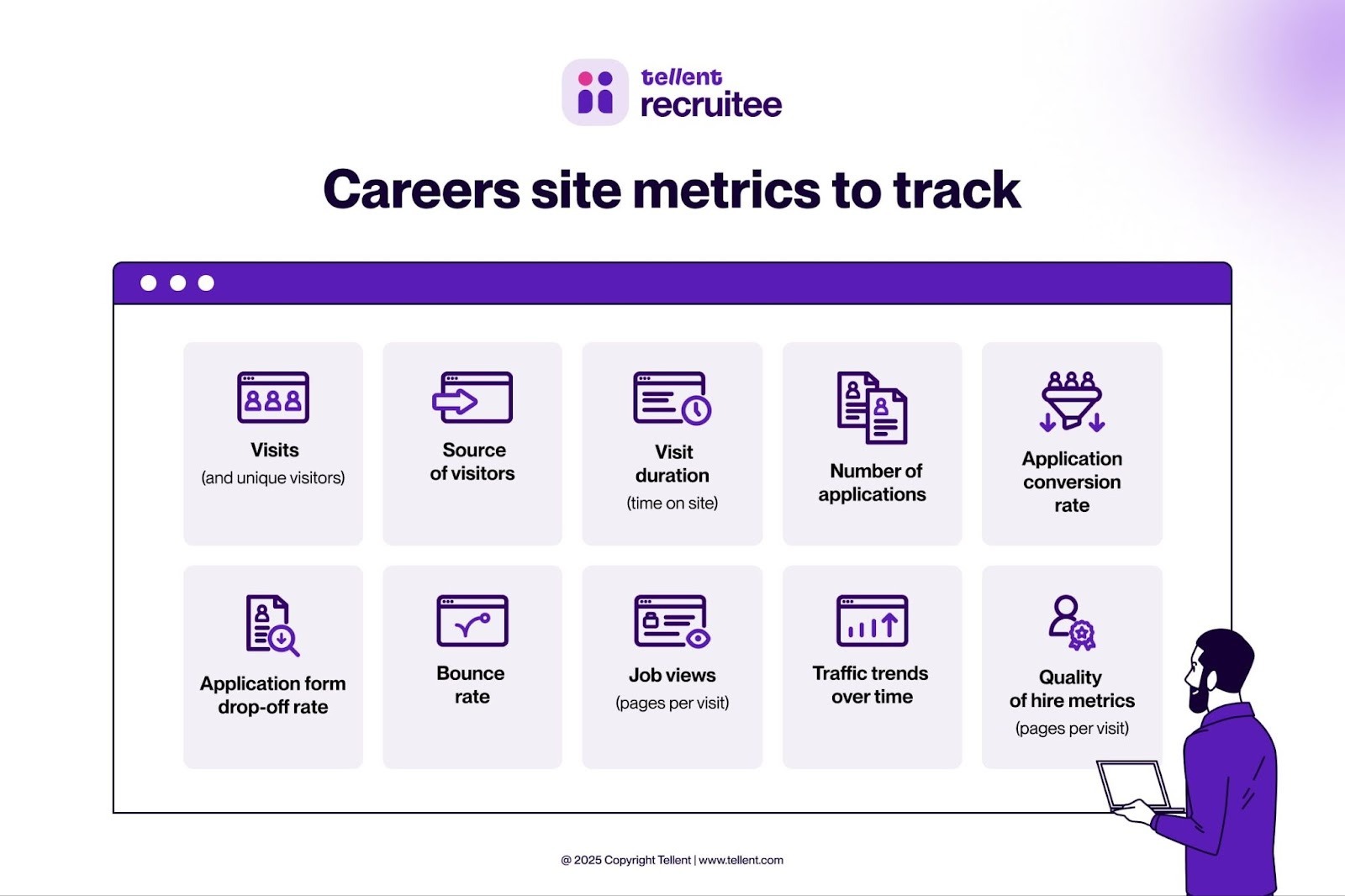
Your company's careers site is likely where the majority of your candidates come from, so understanding how to improve your page to increase candidate conversion will do wonders for your employer brand!
This can be done by using Google Analytics or using Tellent Recruitee’s career site analytics.
As a final note, your career page strategy must be an integrated part of your overall hiring process. It’s not enough to have an isolated career page that doesn’t jive with the rest of the candidate experience.
Be sure that candidates are provided a seamless transition from the careers page to the final handshake.
Your careers page is your employer brand—make it count
No matter what your company does, or how many employees you have, your company has a story to tell, and an employer brand to share.
Creating a killer careers page - and employer brand - is all about leveraging the resources and people available to you, and presenting an authentic vision of your company.
Good stories, combined with the right strategy and design, will turn the career page on your website into a destination that your ideal candidates will actually want to engage with. And when they do engage, as we found in The State of Hiring in 2025 report, candidates are more likely to apply, and you’re more likely to land top talent to move your organization forward.



